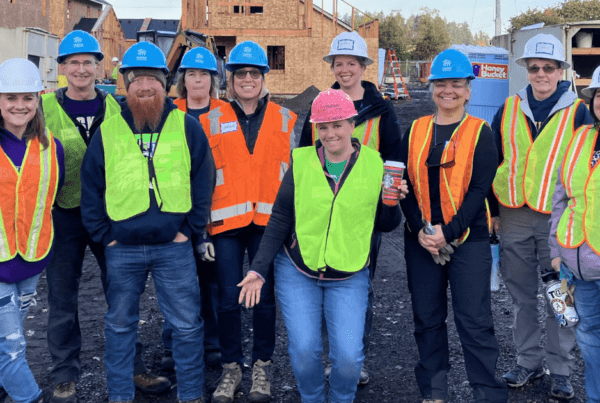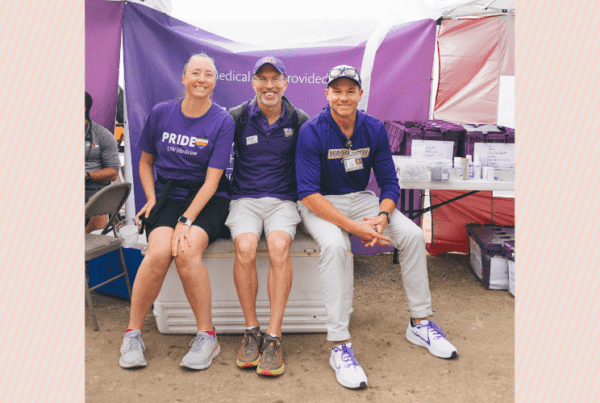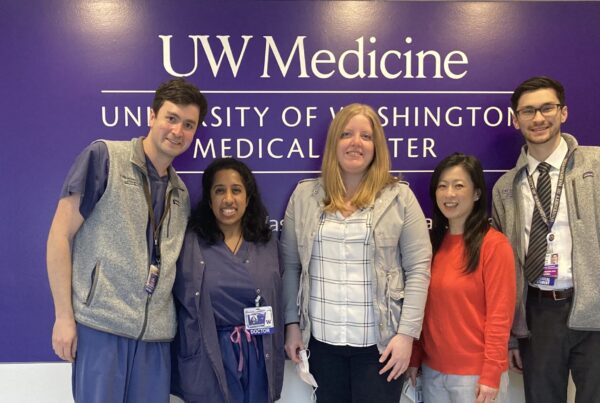Highlights | Fundraising for diabetes care and research
- The UW Medicine Diabetes Institute houses clinics and a research hub.
- Partnering with UW Medicine Advancement enables the Institute’s team to meet their goals.
- Grateful patients are a huge part of philanthropy for the Institute.
- Philanthropy has funded a mental health program, a patient technology navigator, and a young adult transition to independence program for patients with diabetes.
- Teamwork, mutual trust and honoring each other’s strengths are key to the Institute’s success.
There is currently an epidemic of diabetes in the United States. According to the American Diabetes Association, 34.2 million people in the country — including more than 582,000 people in Washington state — have the disease. Most of them have Type 2 diabetes, which is when the body can’t make enough insulin or use it efficiently, but around 1.6 million have Type 1 diabetes, which typically develops during childhood or adolescence and means the body cannot produce any insulin on its own.
Both types require lifelong, individualized care. Here in Washington, patients have access to The UW Medicine Diabetes Institute a first-of-its-kind diabetes care and research hub in the Pacific Northwest.
The Institute is still relatively young — it was established in 1991 with the help of philanthropy and greatly expanded in 2018 at UW South Lake Union — but it is already home to many life-transforming programs for diabetes patients, including a main clinic, a Latinx clinic to help address health disparities, a mental health program, a program that assists young adults in managing their disease and a research unit.
“Our goal was to create an institute that cares for all aspects of the patient and their disease in a multidisciplinary way, incorporating that care under one roof and synergizing it with clinical and basic science research,” explains Stephanie Page, MD, PhD, an endocrinologist, co-director of the Institute and head of the Division of Metabolism, Endocrinology and Nutrition at the UW School of Medicine.
The keys to achieving that goal are world-class patient care, robust and innovative research, and the thing that powers all three: philanthropy.
It starts with gratitude
At the heart of the Diabetes Institute are doctors like Page and her colleague Irl Hirsch, MD, an endocrinologist and diabetes care specialist, who are dedicated to improving the health outcomes of diabetes patients through care and research. Between monitoring blood sugars, managing medications and staying dedicated to lifestyle changes, having diabetes can feel like a full-time job. Hirsch is well aware of this because he has diabetes, too.
Originally from St. Louis, he came to Seattle when UW opened its first diabetes clinic. He was one of two diabetes care providers at UW Medicine. He quickly realized that many doctors still didn’t know much about diabetes treatment — and he wanted to change that. He had a unique perspective, too, as a diabetes care provider who has the condition himself.
“Early on, I would ask patients, ‘Why are you coming to see me?’ They would say they’re tired of knowing more about diabetes than their doctor,” he says.
Between managing his own diabetes, helping others manage theirs, and conducting diabetes research, Hirsch admits that much of his life is consumed by diabetes — but it is this that enables him to connect so well with his patients.
Like him, most of his patients were diagnosed with Type 1 diabetes in childhood. Type 1 is his research focus, too, though he has been involved in major Type 2 trials funded by organizations such as the National Institutes of Health and the American Diabetes Association. He says he gets ideas for research studies from his patients and the struggles they deal with managing the disease.
“What’s been so meaningful to me is I have taken care of huge numbers of patients for 15 to 25 years. Trying to keep patients as healthy as I can, with the tools we have, and while these tools keep changing. It’s been very gratifying for me,” Hirsch says.
The lasting relationships he builds with patients don’t just help them, but countless other people with diabetes in the region and beyond. That’s because most of the donors who help the Institute’s researchers study and develop new and better treatments start out as grateful patients.
“So many of our donors are grateful patients and patient families. They go through something challenging or traumatic, then want to show gratitude for the caregiver or want to help others avoid the suffering they experienced,” explains Kelly Oswald, senior director for philanthropy for UW Medicine Advancement and lead fundraiser for the Institute.
Partnering for success
Knowing when to approach patients about giving takes skill and nuance, which is something both Oswald and Page say Hirsch has an instinct for.
“Irl is so dedicated and successful at understanding our donors. We work closely with him to align the needs of the Institute with what he learns are the needs of his patients,” Page says.
Fundraising isn’t only about talking with grateful patients, though — that’s just the first step. For fundraising to be successful, meeting the needs of the patients, the community and the Institute’s doctors, hours upon hours of strategizing and collaboration are involved among the Advancement team and their faculty partners.
“It’s about trusting the process and trusting each other. With any work you do, it takes time to establish that relationship. We all agree and know that the most important relationship is the one between the faculty member and the patient. It’s about me trusting the faculty member that they’ll involve me when they start to go down that road, and that they’ll trust us in Advancement as the experts in fundraising,” Oswald explains.
When it comes to fundraising for the Diabetes Institute, Page, Hirsch and Oswald work together regularly. They all know that one of the most successful ways to develop new treatments for diabetes and learn how patients can better manage the disease is through fundraising for innovative research projects. Many projects are too novel to be funded by government grants and need private philanthropy in order to see the light of day, Oswald explains.
“Philanthropy also allows us to recruit world-class leaders, make care more accessible and equitable, and bring medical school tuition within reach for students,” she says.
One example she gives is how she worked with donors to fund a technology navigator position at the Institute. This person helps patients understand how to measure their glucose levels and use advanced technology, such as cloud-based apps, to give their doctor access to their health data. This assistance is a lifesaver for patients who have trouble with technology plus it provides vital information for their doctors.
Page, Hirsch and Oswald all bring their own strengths to the team. Page focuses on big-picture goals and how to realistically achieve them. Hirsch serves as the bridge between the team and patients. Both also bring their extensive knowledge of UW and the local community, as they have been at the organization since 1991, Hirsch as a provider and Page as a medical student.
As for Oswald, she brings her expertise in fundraising and building partnerships with faculty, as well as a dedication to UW — she first came to the organization in 2004, left for a little while, and returned in 2016, right around the time Page became division head of Metabolism, Endocrinology and Nutrition.
Oswald says she respects the way Hirsch always comes up with new ideas and the way Page helps the team recognize what they can achieve and how. She enjoys working with both of them — and the feeling is mutual.
“The biggest assets of the institute are the members and our relationship with Kelly who I can’t say enough wonderful things about. It’s transformed our ability to raise philanthropic awareness and donations for the institute,” Page says.
Missions accomplished
Despite the Institute’s youth, the team has already achieved some major fundraising goals that have turned into projects and programs that directly impact the community.
The clinic at the Institute provides not only world-class diabetes care, but also mental health care. Psychologists and psychiatrists who understand the mental health tolls of managing diabetes are available to meet with patients at the clinic and via telemedicine. People with diabetes are at a higher risk for developing depression and anxiety, which makes mental health care that much more vital.
“We thought the mental health program would need a huge amount of ongoing philanthropic support, but we learned how to provide services in a way where we relied on donor funds to get it started, but it’s much more self-sustaining now,” Page says.
Philanthropy also helped launch programs that reach people who are often overlooked and underserved. There’s the Latinx Diabetes Clinic, which seeks to decrease healthcare disparities among Latinx diabetes patients and increase health among Latinx communities. And there’s the Adolescent and Young Adult Diabetes Program, where the goal is to help young people transition from being kids who rely on hands-on pediatric care to independent adults who know how to manage their disease on their own.
“The adolescent program is twenty years in the making. I would meet with Cate Pihoker, who is head of endocrinology at Seattle Children’s, every Saturday afternoon for years to prepare and work on a business plan. The clinic is one of only a few like it in the country. The Latinx clinic was developed by Lorena Wright here at UW Medicine; it only started recently but has already been hugely successful,” Hirsch says.
In order to keep providing the best care, the Institute needs the best researchers. And in order to recruit them, Page has worked with Oswald on several philanthropy projects to fund research projects, including a program that provides seed money to young investigators to do studies that would be difficult to fund elsewhere. Page and Hirsch are also involved in the search for a new director for the Institute, and know that through philanthropy the team will be able to hire the best of the best.
The future is bright
For Hirsch, the best part about his work and the work of the Diabetes Institute team is the years of life and improved disease management they have been able to give to patients — a reality that didn’t seem possible when he started his training.
“When I was a med student, we were taught that half of people after 30 years would be blind, a third would have kidney failure, and their life expectancy would be very short. That’s no longer true. This wasn’t supposed to happen when I was in my training, yet it is. Without trying I’ve become a geriatrician,” Hirsch says.
In fact, geriatrics is an area he wants to see developed more at the Institute in the near future. He hopes to develop a clinic focused on older patients with Type 1 diabetes, a population that didn’t exist just decades ago.
“We don’t know much about them from a research point of view. What’s the ideal blood pressure, cholesterol, blood sugar control? How can we help people who are losing cognitive abilities? What happens when they have to go to a skilled nursing home?” he says.
Page wants to continue to address and rectify healthcare disparities that impact Black, Hispanic, Indigenous, and other people of color who have diabetes. This work involves getting direct community input, which is something the Institute has been doing more recently. She also hopes to partner with local tech companies to advance diabetes technology that improves patients’ lives — a project that will undoubtedly involve philanthropic partnerships.
“I’m hopeful about the future for the UWDMI and our future successes will be exponential if we work in collaboration with our colleagues in Advancement. In the last five years, Advancement has been so positive and they’ve really reinvented how we do philanthropy. I have a lot of gratitude for that help,” she says.


